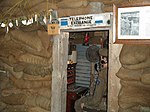Garrison Golf and Curling Club
Garrison Golf & Curling Club is a golf and curling club, located within CFB Kingston in Kingston, Ontario, Canada. Garrison is a private club, primarily for the use of Canadian Forces personnel and Canadian Department of National Defence employees, although civilians are also eligible to join. The Curling Club was established in 1961 with four sheets of ice, which it has operated since that time. The Golf Club began in 1971 with the first nine holes, designed by Richard H. Green, the longtime professional at Cataraqui Golf and Country Club, and Johnny Marsh. The second nine holes of golf were opened in 1985, and were based on a design by Tom McBroom, who has since become one of Canada's leading golf course architects. The golf course has been a frequent host of Ontario and Canadian championships for the Canadian Forces, as well as local, regional, and provincial events. Matt McQuillan, now a member of the Canadian Professional Golf Tour and a tour winner, learned the game at Garrison as a junior player in the 1990s. McQuillan earned 2011 PGA Tour playing privileges in December, 2010.
Excerpt from the Wikipedia article Garrison Golf and Curling Club (License: CC BY-SA 3.0, Authors).Garrison Golf and Curling Club
Grenadier Drive, Kingston
Geographical coordinates (GPS) Address Website Nearby Places Show on map
Geographical coordinates (GPS)
| Latitude | Longitude |
|---|---|
| N 44.251 ° | E -76.449 ° |
Address
Garrison Golf Course
Grenadier Drive
K7L 0C3 Kingston
Ontario, Canada
Open on Google Maps






